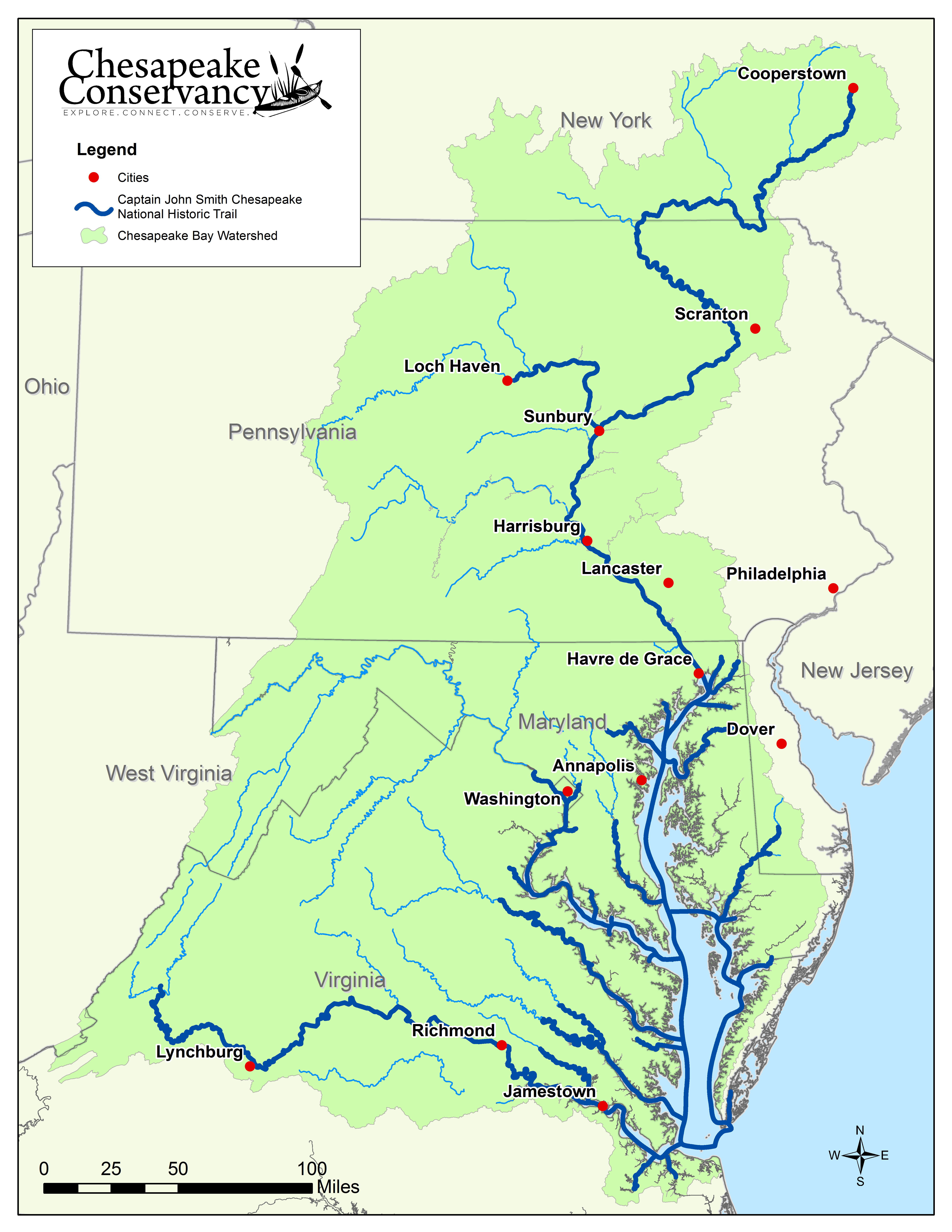Nation’s First All-Water National Historic Trail to Mark its 10th Anniversary
Captain John Smith Chesapeake Trail 10th Anniversary Coincides with National Park Service’s 100thAnniversary
Annapolis, MD – The Captain John Smith Chesapeake National Historic Trail (the Trail) will mark its 10th anniversary this year, coinciding with the celebration of the 100th Anniversary of the National Park Service (NPS). Trail partners and communities will recognize the anniversary with a series of related events and projects this year.
Established on December 19, 2006, the 3,000 mile Trail is administered by the National Park Service Chesapeake Bay Office. The Trail connects people with places evoking the Chesapeake of 400 years ago, and with stories of American Indian communities and culture, of Smith’s 1607-1609 voyages of exploration, and of the Bay and its rivers. The Trail offers opportunities for tourism, environmental and cultural education, conservation, and recreation. The Chesapeake Conservancy serves as the National Park Service Chesapeake Bay office’s primary nonprofit partner on the Trail.
“For the last 10 years, we have embraced the John Smith Chesapeake Trail as the inspiration and framework for large landscape conservation and increased public access throughout the Chesapeake. This landscape shapes our culture and traditions and defines our communities,” Joel Dunn, president and CEO of the Chesapeake Conservancy said. “As the National Park Service celebrates its 100th Anniversary, I’d like to remind people in this region that they have a National Park in our collective backyard. The John Smith Chesapeake Trail, comprising much of the Chesapeake, is as beautiful and precious to our nation as the Grand Canyon, Yellowstone, or Yosemite.”
As the National Park Service celebrates its 100th anniversary this year with the Find Your Park campaign, NPS is sponsoring events and tributes throughout the year to celebrate this milestone, from free admission days in parks, to commemorative coins, to film festivals. The National Park System comprises 409 sites covering more than 84 million acres.
Ten facts about the John Smith Chesapeake Trail:
1. The Captain John Smith Chesapeake National Historic Trail is the first all-water National Historic Trail.
2. The Trail stretches over 3,000 miles, spanning from Cooperstown, New York to Virginia Beach, Virginia.
3. The arrival of English colonists 400 years ago unleashed changes that transformed the Chesapeake landscape. For centuries the native people had lived lightly on the land. But the English brought different farming practices, machinery, and alien species of plants, animals, and insects that drastically altered the natural balance.
4. The English were not the first Europeans to visit the Chesapeake Bay – the Spanish probably got here first. Spanish vessels had likely sailed into the Bay several times in the 1500s. A Spanish map by Diego Gutierrez was the first to record the Chesapeake Bay, although he called it “Bahia de Santa Maria.” The English were the first Europeans to come to Virginia with the intention of staying.
5. When Captain John Smith made his Chesapeake voyages in 1607-1609, there were an estimated 50,000 native people already living in the region. They occupied scores of communities along the Chesapeake and its rivers. Today, the Chesapeake watershed is home to nearly 18 million people.
6. The trail is marked at several places on the water by National Oceanic and Atmospheric Administration (NOAA) buoys as part of the Chesapeake Bay Interpretive Buoy System (CBIBS). Accessible by cell phone or via the Internet, these buoys transmit real-time data as well as historical information for recreational and educational uses.
7. Thousands of acres along the trail are protected for the public to enjoy at national, state, and county parks and wildlife refuges.
8. Smith mapped the Chesapeake and its great rivers with astonishing accuracy using a compass, a sextant, an hourglass, and information shared with him by American Indians. Smith’s map and writings influenced exploration and settlement of eastern North America for many generations, and they are a remarkable partial record of the native cultures and the natural environment of the 17th-century Chesapeake.
9. It is a common misconception that Indians no longer live in the Chesapeake Bay region. In fact, there are tens of thousands of people in Virginia, Maryland, Delaware, Pennsylvania, and the District of Columbia who identify as American Indian.
10. The Chesapeake Bay region is home to 348 species of finfish, 173 species of shellfish, over 2,700 plant species, and 29 species of waterfowl and is a major resting place along the Atlantic Flyway. Every year, over a million waterfowl spend the winter in the Bay region.